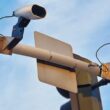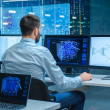Executive Summary:
A technology known as Automatic License Plate Recognition (ALPR) has proven to be an effective tool in several fields, including parking management and law enforcement. Maximizing ALPR efficiency is essential to reach its full potential.
Introduction:
Automatic License Plate Recognition (ALPR) has emerged as a game-changer, revolutionizing how license plate data is recorded and used in a world that is becoming increasingly data-driven. Advanced optical character recognition (OCR) methods are used by ALPR technology to automatically scan and decipher license plate numbers from pictures or video streams.
With uses in toll collection, parking management, law enforcement, and other areas, ALPR has emerged as a crucial tool for streamlining procedures, boosting security, and maximizing ALPR efficiency.
As businesses utilize ALPR systems to their total capacity, the emphasis switches to increasing efficiency to get the most out of this cutting-edge technology.
In this blog, we go into cutting-edge hints and techniques beyond mere installation, enabling organizations to utilize ALPR fully.
Tips To Optimize ALPR Performance:
- Placement of ALPR Cameras:
Selecting the ideal sites for ALPR camera placement is essential for acquiring clear and accurate license plate images. Place cameras with a direct line of sight to oncoming traffic at chokepoints, intersections, and entry/exit points.
Ensure the camera angles are set correctly to record license plates from various vehicle heights and distances.
- Lighting Considerations:
Accurate illumination is essential for ALPR. Choose cameras with integrated infrared lighting to guarantee consistent performance in dim light and at night.
Avoid direct light sources that could produce glare or overexposure because they can impair the system’s ability to read license plates effectively.
- Optimize Data Storage and Management:
Create effective data management and storage plans to deal with the massive amounts of data produced by ALPR systems. For scalability, accessibility, and data backup, use cloud-based solutions.
- Use Image Pre-Processing:
Before submitting images to the ALPR engine, use image pre-processing methods to improve the quality of the photos. Image normalization, contrast correction, and noise reduction are all examples of pre-processing.
- Refine Recognition Algorithms:
Modify the recognition algorithms of the ALPR system to meet certain use cases and enhance accuracy. The settings can be adjusted to produce more accurate findings by lowering false positives and negatives.
- Deep Learning Algorithms:
You might want to incorporate deep learning algorithms into your ALPR system. Deep learning can increase recognition precision, particularly in difficult situations with various license plate patterns or obscured license plates.
- Integration with Existing Systems:
Integrate ALPR with additional pertinent systems to increase impact and improve workflow. To automate operations, connect ALPR with access control, parking management, or security systems, maximizing ALPR efficiency.
Seamless integration is made possible by enhancing data exchange capabilities and offering a complete solution for multiple applications.
- Quality Assurance
Consistent quality assurance is necessary to maintain the best possible performance of the ALPR system. Examine and clean cameras and lenses regularly to prevent dust or dirt obstruction.
Run system tests to find any hardware or software issues and quickly resolve them—additionally, instruct operators on how to use the ALPR system properly.
- Continuous Operator Training:
Educate operators on how to use the ALPR system well and how to decipher its results. Operators with the proper training can make real-time decisions based on the ALPR results, increasing the overall effectiveness and response times.
- Regular Software Updates:
Keep abreast of the most recent ALPR software updates and versions. Software upgrades frequently include bug fixes, performance enhancements, and improvements to identification capabilities.
Minimizing False Positives and Negatives
A crucial part of enhancing an ALPR system’s performance is minimizing false positives and negatives. False positives occur when the system incorrectly recognizes an object that isn’t a license plate as one, while false negatives happen when the system doesn’t detect an actual license plate.
Both circumstances can result in erroneous data, lost productivity, and even harmful outcomes in applications like toll collection or law enforcement.
Here is how to handle these difficulties:
- Improving Recognition Algorithms:
The recognition algorithms are the heart of every ALPR system. These algorithms must be fine-tuned to find the ideal sensitivity and specificity ratio. The degree to which thresholds for character width, height, and spacing are changed can have a significant impact on how healthy objects are recognized.
To make the algorithms more effective for your particular use case, perform extensive testing with various license plate types, fonts, and environmental factors.
- Establishing Confidence Criteria:
Establishing confidence criteria enables you to manage the degree of assurance necessary for a successful license plate read. By changing the threshold, you can choose how confident the ALPR system needs to be before approving a license plate read.
Lowering the confidence level can have the reverse impact by increasing false negatives while decreasing false positives. Find a balance depending on the specifications of the application and the permitted margin of error.
- Making use of Deep Learning Algorithms:
Deep learning algorithms have shown promising results in terms of enhancing ALPR accuracy. These algorithms can learn from enormous quantities of data and adapt to different situations and license plate designs.
Deep learning methods help the ALPR system be more equipped to handle various events, lowering false positives and negatives.
Conclusion:
In conclusion, maximizing ALPR efficiency involves using the technology and optimizing its performance using cutting-edge techniques. Organizations may fully utilize ALPR technology by maximizing camera location, controlling lighting, establishing effective data management procedures, and reducing false positives and negatives.
ALPR transforms into a transformational tool when integrated with current systems, vastly improving operational effectiveness and security in various industries.
FAQS:
Q) What advantages do deep learning algorithms in ALPR offer?
A) Deep learning algorithms increase ALPR accuracy by learning from a massive amount of data. They can adjust to various license plate designs and complex environments, producing more accurate identification results.
Q) How do I handle the massive amounts of data that ALPR systems produce?
A) Utilize effective data management techniques, such as cloud-based services, to manage the massive amounts of data produced by ALPR systems. Make sure that the data is safe, accessible, and complies with any applicable privacy laws.
Q) How might ALPR improve security and law enforcement efforts?
A) By locating stolen vehicles, locating wanted criminals, and keeping an eye on vehicles of interest, ALPR can help police enforcement. ALPR can aid in regulating access to restricted locations for security activities.
Q) Why is camera positioning so important for ALPR effectiveness?
A) Clear license plate photographs are guaranteed by proper camera positioning. Strategically place cameras at junctions and entry/exit points for clear views.
Q) How does lighting impact the precision of ALPR?
A) The accuracy of ALPR is improved in various lighting situations, day or night, by proper lighting, including infrared capabilities.










